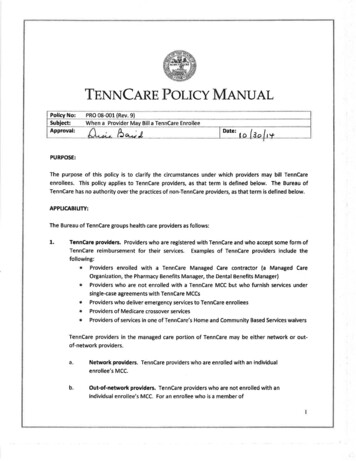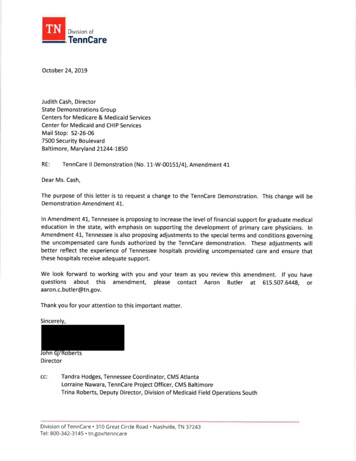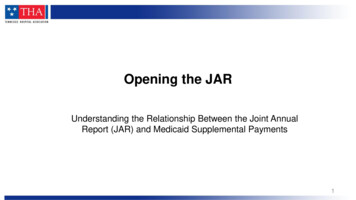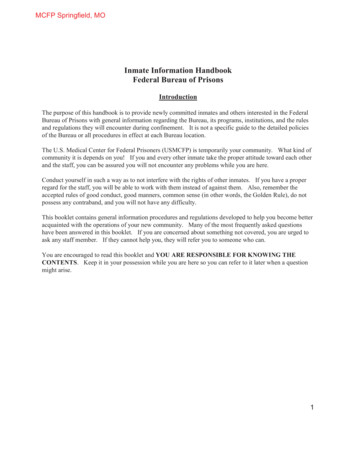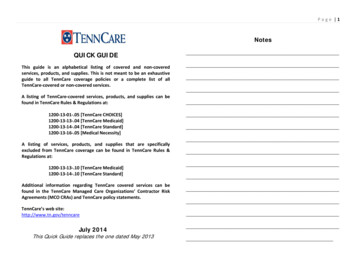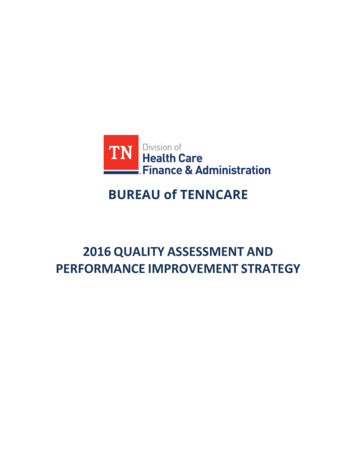
Transcription
BUREAU of TENNCARE2016 QUALITY ASSESSMENT ANDPERFORMANCE IMPROVEMENT STRATEGY
TABLE OF CONTENTSAcronyms . 3Section I: Introduction . 7Managed Care Goals, Objectives, and Overview . 7Strategy Goals and Objectives . 19Development and Review of Quality Strategy . 32Section II: Assessment . 34Quality and Appropriateness of Care. 34National Performance Measures . 37Monitoring and Compliance . 41External Quality Review . 49State Requirements vs. NCQA Accreditation . 51Section III: State Standards . 61Access Standards . 61Structure and Operation Standards . 69Measurement and Improvement Standards . 79Section IV: Improvement and Interventions . 84Interventions with Goals. 84Other Interventions Affecting All Goals and Objectives . 93Intermediate Sanctions. 99Health Information Technology .100Section V: Delivery System and Reforms . 101Section VI: Conclusions and Opportunities . 104Attachments:Attachment I: CRA Access Standards . 110Attachment II: Specialty Network Standards . 112Attachment III: Access and Availability for Behavioral Health Services . 114Attachment IV: Covered Benefits. 117Attachment V: HEDIS Measures . .133Attachment VI: Public Comments .1382
AcronymsAAADAAPACSArea Agency on Aging and DisabilityAmerican Academy of PediatricsAffiliated Computer Services Inc.ADHDAttention Deficit Hyperactivity DisorderADTAdmission, Discharge, TransferAIAudacious InquiryAIUAQSAdopt, Implement, Upgrade toAnnual Quality SurveyASHAbortion, Sterilization, HysterectomyASOAdministrative Services OnlyBABusiness AssociateBCBSTBHOBMIBlueCross BlueShield of TennesseeBehavioral Health OrganizationBody Mass IndexCAHPSCAPConsumer Assessment of Healthcare Providers and SystemsCorrective Action PlanCCMChronic Care Management GroupCCTCare Coordination ToolCDCDCConsumer DirectionCenters for Disease Control and PreventionCFRCode of Federal RegulationsCHATChildren’s Hospital Alliance of TennesseeCHCSCenter for Health Care StrategiesCKMClinical Knowledge ManagementCLSCommunity Living SupportsCLS-FMCMCMSCOPDCRADBMDDCommunity Living Supports-Family ModelCase ManagementCenters for Medicare & Medicaid ServicesChronic Obstructive Pulmonary DiseaseContractor Risk AgreementDental Benefits ManagerDevelopmental DisabilitiesDIDDD-SNPsDHSDepartment of Intellectual and Developmental DisabilitiesDual Special Needs PopulationsDepartment of Human ServicesDMDisease Management3
DMEDurable Medical EquipmentECF CHOICESEDEmployment and Community First CHOICESEmergency DepartmentEDIEHRElectronic Data InterchangeElectronic Health RecordEPEligible ProfessionalEPLSExcluded Parties List SystemEPSDTEQREarly Periodic Screening, Diagnosis and TreatmentExternal Quality ReviewEQROExternal Quality Review OrganizationERCEVVEnhanced Respiratory CareElectronic Visit VerificationFEAFiscal Employer AgentFHSCFirst Health Services CorporationFFMFederally Facilitated MarketFFSFee-For-ServiceHCBSHCFAHome and Community-Based ServicesHealth Care Finance and AdministrationHEDISHHAHealthcare Effectiveness Data and Information SetHome Health AgencyHIEHealth Information ExchangeHIPAAHITHITECHHHSHMOHPEHRMIAMHealth Insurance Portability and Accountability ActHealth Information TechnologyHealth Information Technology for Economic and Clinical HealthHealth and Human ServicesHealth Maintenance OrganizationHewlett Packard EnterpriseHealth Risk ManagementIdentify Access ManagementI/DDIntellectual and Developmental DisabilitiesICF/IIDImmediate Care Facility for Individuals for Individuals with Intellectual DisabilitiesIEPIndividualized Education PlanISPInitial Support PlanIUDIntrauterine Contraceptive DeviceLARCLEIELong Acting Removable ContraceptivesList of Excluded Individuals and EntitiesLEPLimited English ProficiencyLOCLevel of Care4
LTCLong Term CareLTSSLong Term Services and SupportsMCCManaged Care ContractorMCOManaged Care OrganizationMDMMaster Data ManagementMDSMinimum Data SetMFPMoney Follows the PersonMIPPAMLTSSMMISMedicare Improvements for Patients and Providers ActMedicaid Managed Long Term Services and SupportsMedicaid Management Information SystemMRRMedical Record ReviewMUMeaningful UseNASNeonatal Abstinence SyndromeNASUADNCI-ADNCQANDCNEMTNFNational Association of States United for Aging and DisabilitiesNational Core Indicators – Aging and DisabilitiesNational Committee for Quality AssuranceNational Drug CodeNon-emergency Medical TransportationNursing FacilityOCROffice for Civil RightsOeHIOffice of eHealth InitiativesOIGOffice of Inspector GeneralONCOffice of the National Coordinator for Health Information TechnologyORROn Request ReportPAPerformance Activity or Prior AuthorizationPAEPre-Admission EvaluationPAHPPrepaid Ambulatory Health PlanPBMPharmacy Benefits ManagerPCMHPatient Centered Medical HomePCPPrimary Care ProviderPCPPerson-centered PlanningPCSPPerson-Centered Support PlanPDVProvider Data ValidationPERSPersonal Emergency Response SystemsPHPopulation HealthPHIProtected Health InformationPHITPediatric Healthcare Improvement Initiative for Tennessee5
PIHPPrepaid Inpatient Health PlanPIPPerformance Improvement ProjectPIPPProvider Incentive Payment PortalPLHSOPOCPrepaid Limited Health Services OrganizationPlan of CareQAQuality AssuranceQIQuality ty Improvement ActivityQuality Improvement/Utilization ManagementQuality Management/Quality ImprovementQuality Management ProgramQuality OversightQuality Improvement in Long Term Services and SupportsRapid Cycle ImprovementRequest for ProposalSerious Emotional DisturbanceSIMState Innovation Model (grant)SOSSystem of SupportSPMISerious and Persistent Mental IllnessSPOESingle Point of EntrySSASocial Security AdministrationSSISupplemental Security IncomeSTORCSTSStandard Obstetric Record Charting systemShort-term StayTAMHOTDCITennessee Association of Mental Health OrganizationsTennessee Department of Commerce and InsuranceTDMHSASTennessee Department of Mental Health and Substance Abuse ServicesTEDSTennessee Eligibility Determination SystemTNAAPTennessee Chapter of the American Academy of PediatricsTSPNUMTennessee Suicide Prevention NetworkUtilization ManagementWCCWeight Assessment and Counseling for Nutrition and Physical Activity forChildren/Adolescents (WCC) HEDIS6
SECTION I: INTRODUCTIONManaged Care Goals, Objectives, and OverviewCMS Requirement: Include a brief history of the State’s Medicaid managed care programs.On January 1, 1994, Tennessee launched TennCare, a new health care reform program. This originalTennCare waiver, TennCare I, essentially replaced the Medicaid program in Tennessee; Tennessee movedalmost its entire Medicaid program into a managed care model.TennCare I was implemented as a five-year demonstration program and received several extensions afterthe initial waiver expiration date of December 30, 1999. The original TennCare design was extraordinarilyambitious. TennCare I extended coverage to large numbers of uninsured and uninsurable people, andalmost all benefits were delivered by Managed Care Organizations (MCOs) of varying size, operating at fullrisk. Enrollees under the TennCare program are eligible to receive only those medical items and servicesthat are within the scope of defined benefits for which the enrollee is eligible and determined by theTennCare program to be medically necessary.TennCare II, the demonstration program that started on July 1, 2002, revised the structure of the originalprogram in several important ways. The program was divided into "TennCare Medicaid” and “TennCareStandard." TennCare Medicaid served Medicaid eligibles, while TennCare Standard served thedemonstration population.When TennCare II began, several MCOs were either leaving the program or at risk of leaving the programdue to their inability to maintain financial viability. A Stabilization Plan was introduced under TennCare IIwhereby the MCOs were temporarily removed from risk. Pharmacy benefits and dental benefits werecarved out of the MCO scope of services, and new single benefit managers were selected for thoseservices. Enrollment of demonstration eligibles was sharply curtailed, with new enrollment being openonly to uninsurable persons with incomes below poverty and "Medicaid rollovers,” persons losingMedicaid eligibility who met the criteria for the demonstration population.In 2004, in the face of projections that TennCare’s growth would soon make it impossible for the state tomeet its obligations in other critical areas, Governor Phil Bredesen proposed a TennCare Reform packageto accomplish goals such as "rightsizing" program enrollment and reducing the dramatic growth inpharmacy spending. With approval from the Centers for Medicare & Medicaid Services (CMS), the statebegan implementing these modifications in 2005.On October 5, 2007, the waiver for the TennCare II extension was approved for three additional years.Subsequent extensions of the TennCare II managed care demonstration were approved in 2009 and 2013.The integration of behavioral health into the managed care model evolved from the TennCare I waiver. In1996, behavioral health services were carved out and the Partner’s program was established wherebyBehavioral Health Organizations (BHOs) contracted directly with the Bureau of TennCare to managebehavioral health services. A primary focus of the carve-out was to provide services for the prioritypopulation, a group that included adults with serious and persistent mental illness (SPMI) and childrenwith serious emotional disturbance (SED). The Bureau began integrating behavioral and medical healthcare delivery for Middle Tennessee members in 2007 with the implementation of two expanded MCOs.7
TennCare continued the process with the implementation of new MCO contracts in West Tennessee inNovember 2008 and East Tennessee in January 2009. The transferring of behavioral health services toVolunteer State Health Plan of Tennessee for TennCare Select members completed the Bureau’s phased-inimplementation of a fully integrated service delivery system that works with health care providers,including doctors and hospitals, to ensure that TennCare members receive all of their medical andbehavioral services in a coordinated and cost-effective manner.On July 22, 2009 TennCare received approval from CMS for a demonstration amendment to implementthe CHOICES program outlined by the State’s Long-term Care and Community Choices Act of 2008. Underthe CHOICES program the State provides community-based alternatives to people who would otherwiserequire Medicaid-reimbursed care in a Nursing Facility (NF), and to those at risk of Nursing Facility (NF)placement. The CHOICES program utilizes the existing Medicaid MCOs to provide eligible individuals withnursing facility services or home and community based services. Tennessee was one of the first states inthe country to implement managed Medicaid long- term care and the only state to do so in a manner thatdoes not require enrollees to change their MCO.The CHOICES program was implemented in stages over time in different geographic areas of the state. Thefirst phase of the CHOICES program was successfully implemented in Middle Tennessee on March 1, 2010,with the East and West Grand Region MCOs’ implementation occurring in August 2010. Also, in August2010, the Statewide Home and Community Based Waiver for the Elderly and Disabled was terminated as itwas no longer needed with full implementation of the CHOICES program.With implementation of the CHOICES program, the MCOs became responsible for coordination of allmedical, behavioral, and long-term care services provided to their members, age 65 and older and adultsage 21 and older with physical disabilities. Currently, the only remaining carve-out services are for dentaland pharmacy services, as well as individuals with intellectual disabilities.Effective July 1, 2016, the Employment and Community First CHOICES program was added to the managedcare demonstration. Employment and Community First CHOICES is an integrated managed long-termservices and supports program that is specifically geared toward promoting and supporting integrated,competitive employment and independent, integrated community living as the first and preferred optionfor individuals with intellectual and development disabilities (I/DD).With implementation of Employment and Community First CHOICES, MCOs are responsible forcoordination of all medical, behavioral, and LTSS provided to individuals with I/DD newly enrolling in HCBSunder the new MLTSS program. Section 1915(c) waivers will continue to be carved out of managed care,although individuals enrolled in those waivers are enrolled in managed care for their physical andbehavioral health services. Members enrolled in a Section 1915(c) waiver will have the opportunity toelect transition to the Employment and Community First CHOICES program at a future date.MCO Contracting and Turnover ExperienceTraditionally, MCOs, operating in the TennCare demonstration, have been "at risk." However, because ofinstability among some of the MCOs participating in TennCare, the "at risk" concept was replaced in July2002 with an "administrative services only" arrangement. The state added its own MCO, TennCare Select,to serve as a backup if other plans failed or there was inadequate MCO capacity in any area of the state.TennCare Select also serves enrollees in specific populations such as foster children, children receiving8
Supplemental Security Income (SSI) benefits, and children receiving services in a nursing facility or anIntermediate Care Facility for Persons with Intellectual Disabilities.Maintaining MCO participation in Middle Tennessee has been a focus of the program over the years.During the 2006-2007 state fiscal year, one of the major TennCare priorities was recruiting well-run, wellcapitalized MCOs to Middle Tennessee. In addition to bringing in new MCOs, the Bureau wanted toestablish a new service-delivery model – an integrated medical and behavioral health model. Anothercrucial factor in the implementation was structuring the MCOs' contracts to return the organizations to fullfinancial risk. To meet these goals, the state conducted its first competitive procurement process forTennCare MCOs. The Bureau secured contracts with two successful bidders. The two new MCOs "wentlive" on schedule on April 1, 2007. TennCare placed the managed care contracts for the East and Westgrand regions of the state up for competitive bid in January 2008. In April 2008, the state awarded theregional contracts to two companies in each region. The MCO contractors accepted full financial risk toparticipate in the program and the new contracts also established an integrated medical and behavioralhealth care system for members. The plans began serving West Tennessee members on November 1, 2008and began serving East Tennessee members on January 1, 2009. In September 2009, behavioral healthservices for TennCare Select enrollees were transferred to BCBST.For most of TennCare’s history, managed care organizations (MCOs) delivered services on a regional basis(e.g., East Tennessee, Middle Tennessee, and West Tennessee). On October 2, 2013, the Bureau ofTennCare issued a Request for Proposals (RFP) for three organizations to furnish managed care servicesstatewide to the TennCare population. The RFP required the winning bidders to provide physical healthservices, behavioral health services, and Long Term Services and Supports (LTSS) throughout the state,with actual service delivery to begin in Middle Tennessee on January 1, 2015, and in East and WestTennessee later that calendar year.On December 16, 2013, the Bureau announced that the winning proposals had been submitted byAmerigroup, BlueCare, and UnitedHealthcare, the three companies that currently form TennCare’smanaged care network. New contracts with these entities will last from January 1, 2014 throughDecember 31, 2016 and contain options for five (5) one (1) year extensions.Between 1994 and 2002, dental services were part of physical health services delivered by TennCare’smedical MCOs. Some MCOs chose to contract directly with dentists and operate their own dentalnetworks, while others subcontracted their dental program to a Dental Benefits Manager (DBM). Duringthis time, dentists did not participate in the TennCare program to the extent desired or anticipated by theState. Differences in the practice of dentistry versus medicine made participation in a managed care“medical” model a challenging business decision for dentists. Dentists complained of inefficienciesassociated with participation in multiple MCOs relative to credentialing, authorization, billing, andreimbursement. Each MCO or its dental subcontractor negotiated dental reimbursement rates individuallywith dentists, and fees were a confidential, contractual matter. Most dentists only signed contracts withcertain MCOs, which complicated efforts to ensure enrollee access. Effective October 2002, in an effort tostrengthen dental provider networks and improve enrollee access to care, the State moved from amanaged care medical model to a managed care dental model for administration of dental services. Thedental benefit was removed (carved-out) from the MCOs. Definitive funding was allocated for therevamped dental program, and administration of the dental benefit was awarded to a single DBMfollowing a competitive bid process. The dental contract was an Administrative Services Only (ASO)9
contract where the DBM was not financially “at risk” for delivery of dental care. The State paid the DBM anadministrative fee for managing the dental benefit and covered expenditures associated with dentalclaims. In 2013, TennCare transitioned from an ASO contract to a partial risk bearing contract to reflect thematuration of the DBM model and to provide additional incentives for the DBM to improve quality ofdental care while lowering costs.The Dental carve-out model has proven to be beneficial for the State, enrollees, and providers. DBMadministration has resulted in more streamlined administrative processes making the program more“dental” friendly for providers. Dentists sign one provider agreement, are subjected to one credentialingprocess, and are reimbursed on a fee-for-service basis using one approved maximum allowable dental feeschedule. A single DBM means there is one set of program policies, one provider agreement, one providerreference manual, one claims processor, and one organization responsible for all contract deliverables.State oversight of Medicaid dental services is simplified because the Bureau of TennCare is responsible forone DBM versus multiple MCOs delivering or subcontracting for dental care.The DBM has also been responsible, among other things, for maintaining and managing an adequatestatewide dental provider network, processing and paying claims, managing program data, conductingutilization management and utilization review, detecting fraud and abuse, as well as meeting utilizationbenchmarks or outreach efforts reasonable calculated to ensure participation of all children who have notreceived screenings.As mentioned, the pharmacy program was carved out of the managed care plans in 2003 and transferredto a single Pharmacy Benefits Manager (PBM) payer system, which still remains in place today. The firstPBM, Affiliated Computer Services (ACS), went into effect for the latter half of 2003 and established thepreferred drug list. First Health Services Corporation (FHSC) became the PBM in 2004 and remained until2008. SXC Health Solutions (which later became known as Catamaran) followed FHSC until 2013 at whichtime Magellan Medicaid Administration became the current PBM.The largest drivers of change in pharmacy utilization since the carve-out came with a change in a federalConsent Decree in 2005 and establishment of the Medicare Part D program in 2006. These changesallowed TennCare to more effectively manage the pharmacy program and shifted most dual eligiblemembers to a Medicare drug plan.Each enrollee has an MCO for his/her primary care, medical/surgical, mental health and substance abuse,and long-term health services and a Pharmacy Benefits Manager (PBM) for his/her pharmacy services.Children under the age of 21 and enrolled in the TennCare program are eligible for dental services, whichare provided by a Dental Benefits Manager (DBM).Population Description/ChangesAll Medicaid and demonstration eligibles are enrolled in TennCare, including those are dually eligible forTennCare and Medicare. There are approximately 1.45 million persons currently enrolled in TennCare.There are several mechanisms for TennCare eligibility.TennCare Medicaid serves Tennesseans who are eligible for a Medicaid program. Some of the groupsTennCare Medicaid covers include: Low income children under age 2110
Women who are pregnant Caretakers of a minor child Individuals who need treatment for breast or cervical cancer People who receive Supplemental Security Income (SSI). People who have received both an SSI check and a Social Security check for the same month atleast once since April 1977 AND who still receive a Social Security check People who live in a nursing home and have income below 2,022 per month (300% of SSIbenefit) OR receive other long-term care services that TennCare pays forTennCare Standard is only available for children under age 19 who are losing their TennCare MedicaidAND Lack access to group health insurance through their parents’ employer.There are two ways these children can qualify and be able to keep their healthcare benefits: The Uninsured category is only available to children under age 19 whose TennCare Medicaideligibility is ending, who do not have access to insurance through a job or a family member’s job,and whose family incomes are below 211% of the poverty level. The Medically Eligible category is only available to children under age 19 whose TennCareMedicaid eligibility is ending and whose family income equals or is greater than 211% of thepoverty level. To be medically eligible, the child must have health conditions that make the child“uninsurable” from a pre-Affordable Care Act perspective.Coinsurance for some services is required for members with TennCare Standard if the family income isover ninety-nine percent (99%) of the poverty level.TennCare Standard also includes a number of demonstration eligibility categories for individuals enrolledin CHOICES and in Employment Community First CHOICES.CHOICES in Long-Term Services and SupportsIn July 2009, CMS approved an amendment to the TennCare waiver that allows MCOs to coordinate all ofthe care a TennCare member needs, including medical, behavioral, and long-term services and supportsfor specified populations. Implementation of CHOICES for the Middle Grand Region MCOs occurred onMarch 1, 2010, and subsequently for the East and West Grand Region MCOs on August 1, 2010. Initialimplementation included two CHOICES groups: CHOICES Group 1 and CHOICES Group 2, with CHOICESGroup 3 beginning on July 1, 2012.CHOICES Group 1 is for individuals receiving services in a Nursing Facility (NF). These individuals areenrolled in TennCare Medicaid, except for individuals continuously enrolled in CHOICES Group 1 sincebefore July 1, 2012 that do not meet the new nursing facility level of care criteria in effect as of July 1,2012, but continue to meet the level of care criteria in effect prior to July 1, 2012, and are eligible in thedemonstration CHOICES 1 and 2 Carryover Group.CHOICES Group 2 is for individuals who meet the NF Level of Care (LOC) and are receiving Home andCommunity-Based Services (HCBS) as an alternative to NF care. Those in CHOICES 2 may be enrolled ineither TennCare Medicaid, if they are SSI-eligible, or in the demonstration CHOICES 217-Like HCBS Group11
or CHOICES 1 and 2 Carryover Group. The CHOICES 217-Like HCBS Group is composed of adults age 65 andolder, or age 21 and older with physical disabilities, who: Meet the NF level of care requirement; Are receiving HCBS; and Would be eligible in the same manner as specified under 42 CFR § 435.217, 435.236, and435.726, and Section 1924 of the Social Security Act, if the HCBS were provided under a Section1915(c) waiver. With the statewide implementation of CHOICES, the Bureau no longer providesHCBS for older adults and adults with physical disabilities under a Section 1915(c) waiver.Individuals continuously enrolled in CHOICES Group 2 since before July 1, 2012 who do not meet thenew nursing facility level of care criteria in effect as of July 1, 2012, but continue to meet the level ofcare criteria in effect prior to July 1, 2012, and who meet institutional income standards are eligible inthe demonstration CHOICES 1 and 2 Carryover Group.CHOICES Group 3 was implemented July 1, 2012. This option is for individuals age 65 and older, andadults age 21 and older with physical disabilities, who qualify for TennCare as SSI recipients or in the AtRisk Demonstration Group, who do not meet the nursing facility level of care, but who, in the absenceof HCBS, are “at-risk” for nursing facility care, as defined by the State.Interim CHOICES Group 3 was closed to new enrollment on June 30, 2015. Individuals who applied forthe program before July 1, 2015 and are enrolled in Interim CHOICES Group 3 are permitted to remainin the group so long as they continue to meet financial and medical criteria and remain continuouslyenrolled in TennCare in in Interim CHOICES Group 3.In November 2010, Tennessee was recognized by the Center for Health Care Strategies (CHCS) for itsstatewide implementation of the new TennCare CHOICES Long Term Services and Supports program. Inits report Profiles of State Innovation: Roadmap for Managing Long-Term Supports and Services, CHCSidentified Tennessee as one of five innovative states with demonstrated expertise in managed careapproaches to long-term care. Tennessee, along with Arizona, Hawaii, Texas and Wisconsin, was notedas a “true pioneer” in designing innovative approaches to delivering care to the elderly and adults withdisabilities. Tennessee in particular was recognized for its open communication and collaboration withthe public and stakeholders in designing and implementing the new program.The key component of the CHOICES program is person-centered care coordination. The “whole person”care coordination approach includes: Implementation of active transition and diversion programs for people who can be safely andeffectively supported at home or in another integrated community setting outside the nursinghome; and Installation of an electronic visit verification system to monitor home care access, timeliness andquality through the use of GPS technology, and to immediately address potential gaps in care.Other components of CHOICES include: Consumer choice of service setting and providers Consumer-directed care options, including the ability to hire non-traditional providers likefamily members, friends, and neighbors with accountability for taxpayer funds.12
Broadening of residential care choices in the community beyond nursing facilities with optionssuch as companion care, community living supports and adult “foster” family livingarrangements and improved access to assisted care living facilities. Simplified Process for Accessing Services Streamlining the member’s eligibility process for faster service delivery and the enrollmentprocess for new providers. Maintaining a single point of
TennCare waiver, TennCare I, essentially replaced the Medicaid program in Tennessee; Tennessee moved almost its entire Medicaid program into a managed care model. TennCare I was implemented as a five-year demonstration program and received several extensions after
